PD14 International Business: Outsourcing Advantages and Disadvantages
VerifiedAdded on 2023/04/08
|9
|2413
|145
Report
AI Summary
This report examines the concept of outsourcing in international business, a strategy gaining popularity among contemporary businesses. It delves into the advantages and disadvantages of manufacturing in-house versus outsourcing, considering factors such as cost, control, innovation privacy, and customization. The report uses real-world examples like Tesla, Airbus, and Apple to illustrate these concepts. It explores the cost-effectiveness of outsourcing, the risks of leaking innovation, and the challenges posed by government regulations and transportation. The analysis includes a recommended action plan, advocating for a balanced approach that combines in-house development of core competencies with outsourcing non-core areas, exemplified by Toyota's manufacturing process. The report concludes that both in-house and outsourcing models have their merits, and the optimal approach depends on the specific organizational context and strategic goals.
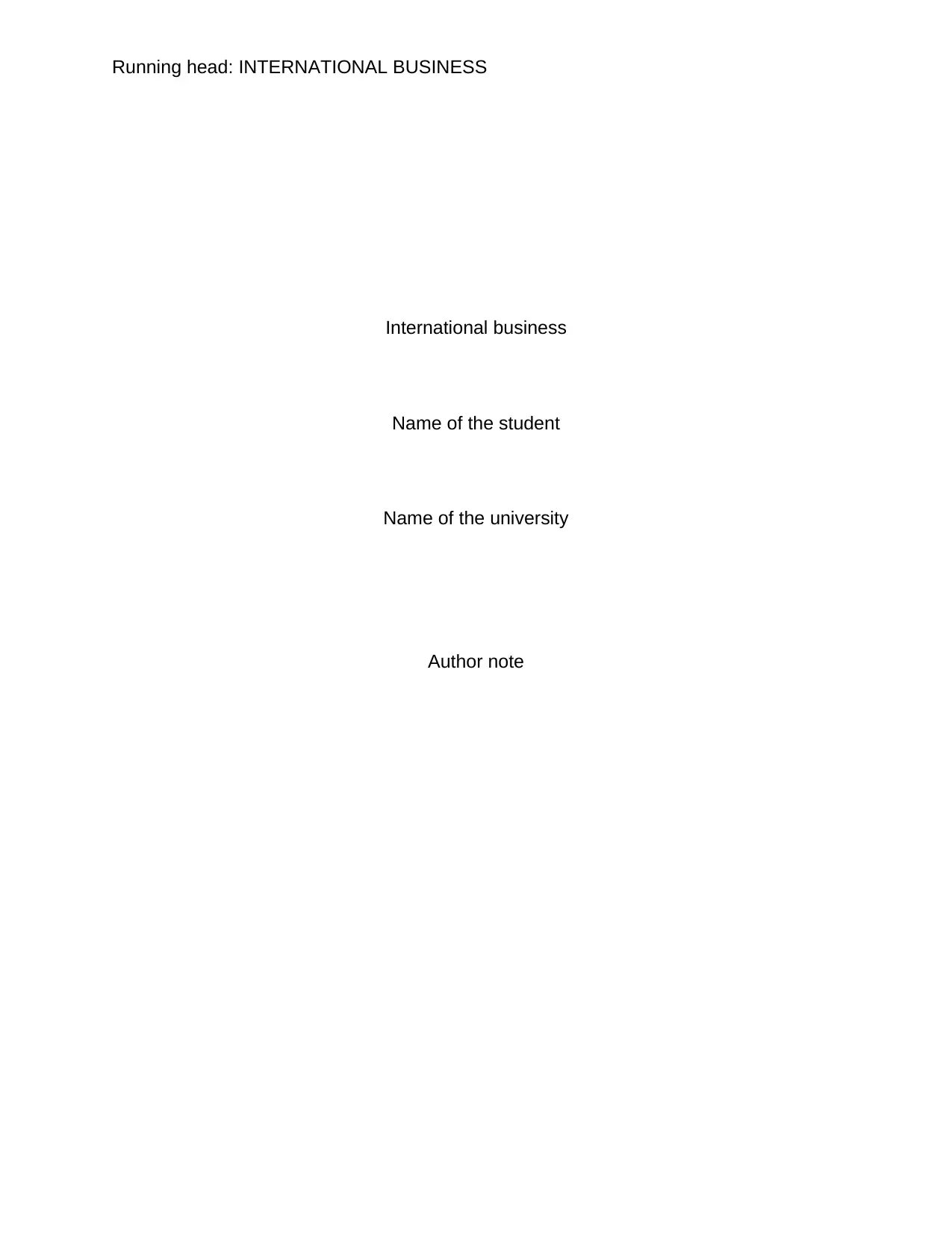
Running head: INTERNATIONAL BUSINESS
International business
Name of the student
Name of the university
Author note
International business
Name of the student
Name of the university
Author note
Paraphrase This Document
Need a fresh take? Get an instant paraphrase of this document with our AI Paraphraser
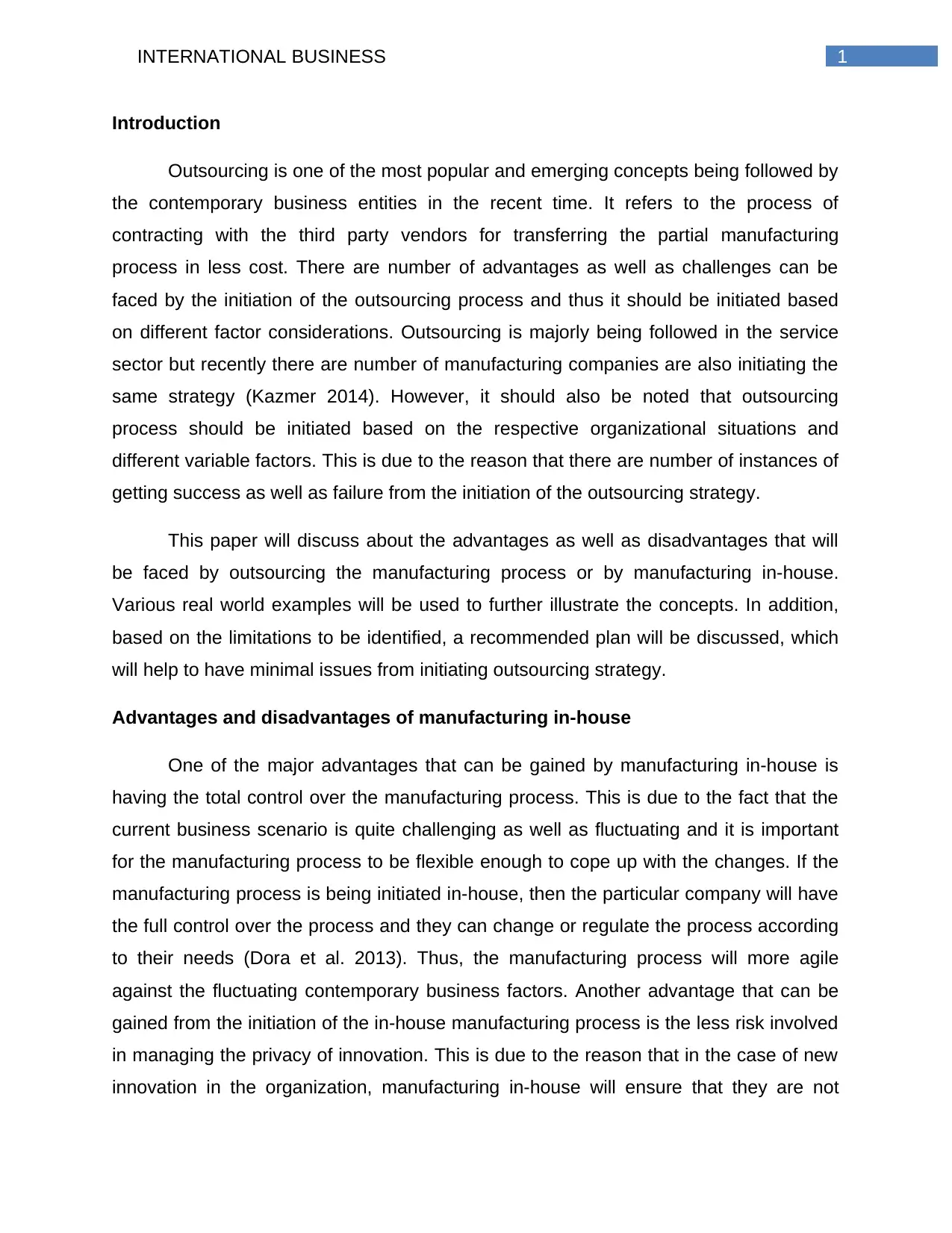
1INTERNATIONAL BUSINESS
Introduction
Outsourcing is one of the most popular and emerging concepts being followed by
the contemporary business entities in the recent time. It refers to the process of
contracting with the third party vendors for transferring the partial manufacturing
process in less cost. There are number of advantages as well as challenges can be
faced by the initiation of the outsourcing process and thus it should be initiated based
on different factor considerations. Outsourcing is majorly being followed in the service
sector but recently there are number of manufacturing companies are also initiating the
same strategy (Kazmer 2014). However, it should also be noted that outsourcing
process should be initiated based on the respective organizational situations and
different variable factors. This is due to the reason that there are number of instances of
getting success as well as failure from the initiation of the outsourcing strategy.
This paper will discuss about the advantages as well as disadvantages that will
be faced by outsourcing the manufacturing process or by manufacturing in-house.
Various real world examples will be used to further illustrate the concepts. In addition,
based on the limitations to be identified, a recommended plan will be discussed, which
will help to have minimal issues from initiating outsourcing strategy.
Advantages and disadvantages of manufacturing in-house
One of the major advantages that can be gained by manufacturing in-house is
having the total control over the manufacturing process. This is due to the fact that the
current business scenario is quite challenging as well as fluctuating and it is important
for the manufacturing process to be flexible enough to cope up with the changes. If the
manufacturing process is being initiated in-house, then the particular company will have
the full control over the process and they can change or regulate the process according
to their needs (Dora et al. 2013). Thus, the manufacturing process will more agile
against the fluctuating contemporary business factors. Another advantage that can be
gained from the initiation of the in-house manufacturing process is the less risk involved
in managing the privacy of innovation. This is due to the reason that in the case of new
innovation in the organization, manufacturing in-house will ensure that they are not
Introduction
Outsourcing is one of the most popular and emerging concepts being followed by
the contemporary business entities in the recent time. It refers to the process of
contracting with the third party vendors for transferring the partial manufacturing
process in less cost. There are number of advantages as well as challenges can be
faced by the initiation of the outsourcing process and thus it should be initiated based
on different factor considerations. Outsourcing is majorly being followed in the service
sector but recently there are number of manufacturing companies are also initiating the
same strategy (Kazmer 2014). However, it should also be noted that outsourcing
process should be initiated based on the respective organizational situations and
different variable factors. This is due to the reason that there are number of instances of
getting success as well as failure from the initiation of the outsourcing strategy.
This paper will discuss about the advantages as well as disadvantages that will
be faced by outsourcing the manufacturing process or by manufacturing in-house.
Various real world examples will be used to further illustrate the concepts. In addition,
based on the limitations to be identified, a recommended plan will be discussed, which
will help to have minimal issues from initiating outsourcing strategy.
Advantages and disadvantages of manufacturing in-house
One of the major advantages that can be gained by manufacturing in-house is
having the total control over the manufacturing process. This is due to the fact that the
current business scenario is quite challenging as well as fluctuating and it is important
for the manufacturing process to be flexible enough to cope up with the changes. If the
manufacturing process is being initiated in-house, then the particular company will have
the full control over the process and they can change or regulate the process according
to their needs (Dora et al. 2013). Thus, the manufacturing process will more agile
against the fluctuating contemporary business factors. Another advantage that can be
gained from the initiation of the in-house manufacturing process is the less risk involved
in managing the privacy of innovation. This is due to the reason that in the case of new
innovation in the organization, manufacturing in-house will ensure that they are not
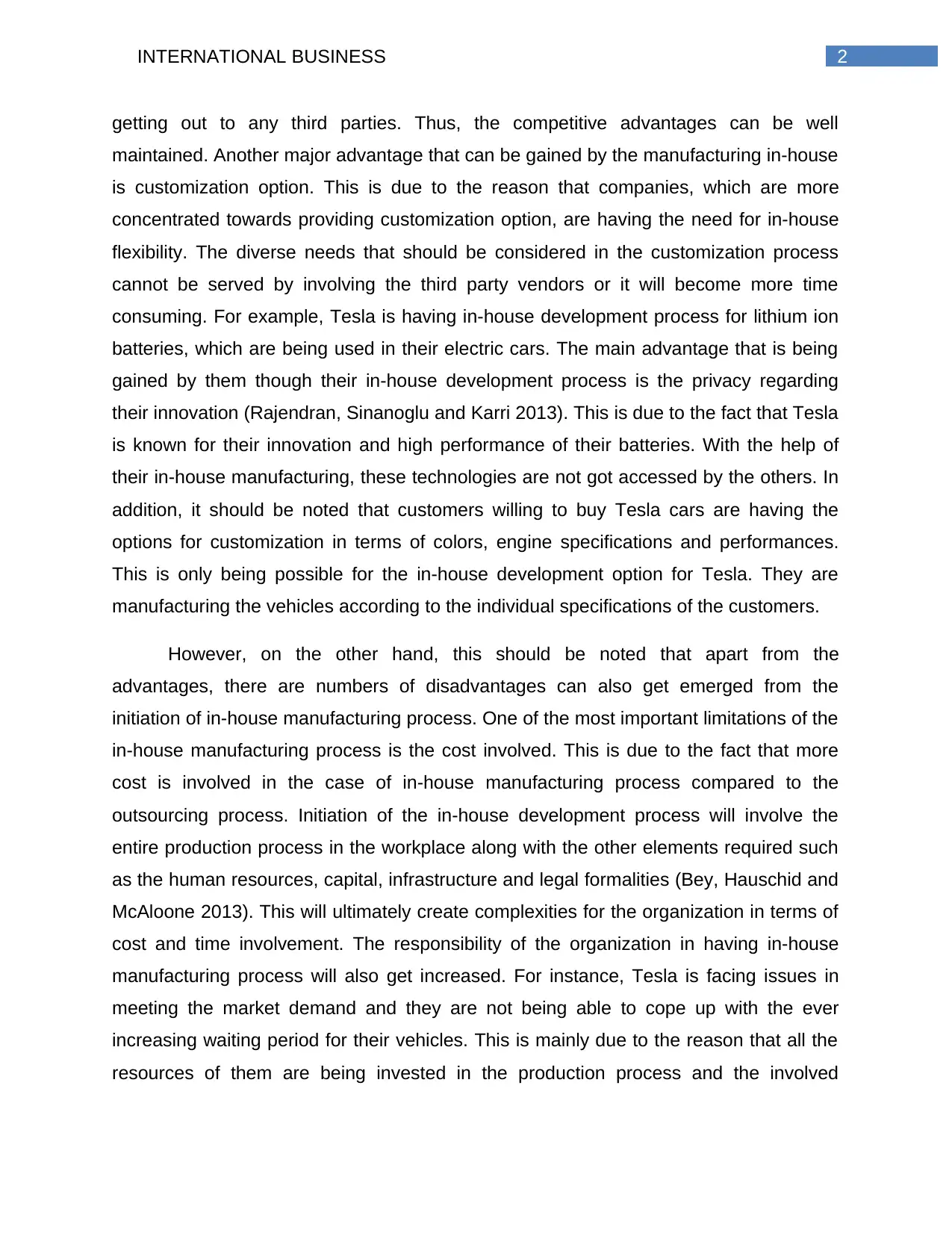
2INTERNATIONAL BUSINESS
getting out to any third parties. Thus, the competitive advantages can be well
maintained. Another major advantage that can be gained by the manufacturing in-house
is customization option. This is due to the reason that companies, which are more
concentrated towards providing customization option, are having the need for in-house
flexibility. The diverse needs that should be considered in the customization process
cannot be served by involving the third party vendors or it will become more time
consuming. For example, Tesla is having in-house development process for lithium ion
batteries, which are being used in their electric cars. The main advantage that is being
gained by them though their in-house development process is the privacy regarding
their innovation (Rajendran, Sinanoglu and Karri 2013). This is due to the fact that Tesla
is known for their innovation and high performance of their batteries. With the help of
their in-house manufacturing, these technologies are not got accessed by the others. In
addition, it should be noted that customers willing to buy Tesla cars are having the
options for customization in terms of colors, engine specifications and performances.
This is only being possible for the in-house development option for Tesla. They are
manufacturing the vehicles according to the individual specifications of the customers.
However, on the other hand, this should be noted that apart from the
advantages, there are numbers of disadvantages can also get emerged from the
initiation of in-house manufacturing process. One of the most important limitations of the
in-house manufacturing process is the cost involved. This is due to the fact that more
cost is involved in the case of in-house manufacturing process compared to the
outsourcing process. Initiation of the in-house development process will involve the
entire production process in the workplace along with the other elements required such
as the human resources, capital, infrastructure and legal formalities (Bey, Hauschid and
McAloone 2013). This will ultimately create complexities for the organization in terms of
cost and time involvement. The responsibility of the organization in having in-house
manufacturing process will also get increased. For instance, Tesla is facing issues in
meeting the market demand and they are not being able to cope up with the ever
increasing waiting period for their vehicles. This is mainly due to the reason that all the
resources of them are being invested in the production process and the involved
getting out to any third parties. Thus, the competitive advantages can be well
maintained. Another major advantage that can be gained by the manufacturing in-house
is customization option. This is due to the reason that companies, which are more
concentrated towards providing customization option, are having the need for in-house
flexibility. The diverse needs that should be considered in the customization process
cannot be served by involving the third party vendors or it will become more time
consuming. For example, Tesla is having in-house development process for lithium ion
batteries, which are being used in their electric cars. The main advantage that is being
gained by them though their in-house development process is the privacy regarding
their innovation (Rajendran, Sinanoglu and Karri 2013). This is due to the fact that Tesla
is known for their innovation and high performance of their batteries. With the help of
their in-house manufacturing, these technologies are not got accessed by the others. In
addition, it should be noted that customers willing to buy Tesla cars are having the
options for customization in terms of colors, engine specifications and performances.
This is only being possible for the in-house development option for Tesla. They are
manufacturing the vehicles according to the individual specifications of the customers.
However, on the other hand, this should be noted that apart from the
advantages, there are numbers of disadvantages can also get emerged from the
initiation of in-house manufacturing process. One of the most important limitations of the
in-house manufacturing process is the cost involved. This is due to the fact that more
cost is involved in the case of in-house manufacturing process compared to the
outsourcing process. Initiation of the in-house development process will involve the
entire production process in the workplace along with the other elements required such
as the human resources, capital, infrastructure and legal formalities (Bey, Hauschid and
McAloone 2013). This will ultimately create complexities for the organization in terms of
cost and time involvement. The responsibility of the organization in having in-house
manufacturing process will also get increased. For instance, Tesla is facing issues in
meeting the market demand and they are not being able to cope up with the ever
increasing waiting period for their vehicles. This is mainly due to the reason that all the
resources of them are being invested in the production process and the involved
⊘ This is a preview!⊘
Do you want full access?
Subscribe today to unlock all pages.

Trusted by 1+ million students worldwide
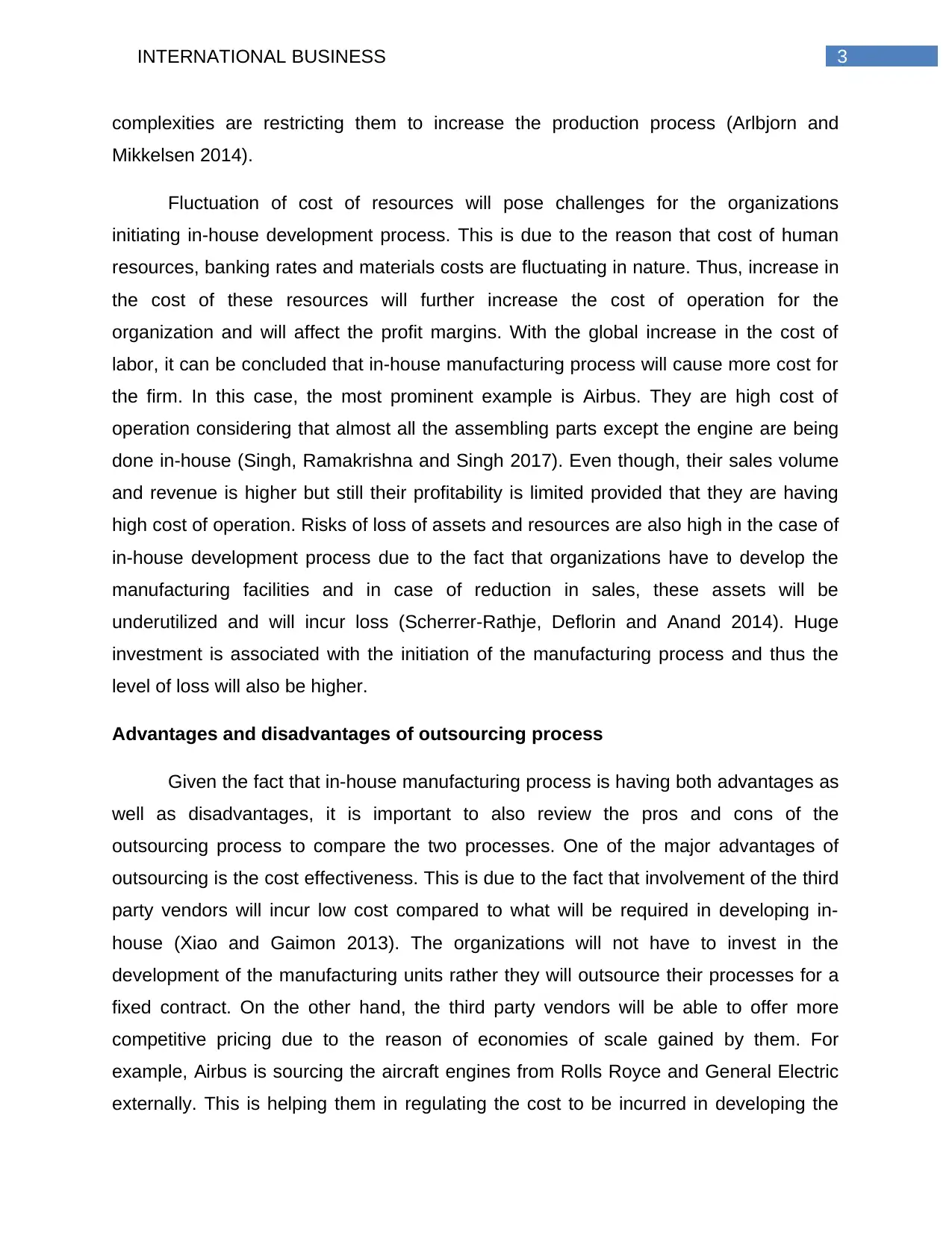
3INTERNATIONAL BUSINESS
complexities are restricting them to increase the production process (Arlbjorn and
Mikkelsen 2014).
Fluctuation of cost of resources will pose challenges for the organizations
initiating in-house development process. This is due to the reason that cost of human
resources, banking rates and materials costs are fluctuating in nature. Thus, increase in
the cost of these resources will further increase the cost of operation for the
organization and will affect the profit margins. With the global increase in the cost of
labor, it can be concluded that in-house manufacturing process will cause more cost for
the firm. In this case, the most prominent example is Airbus. They are high cost of
operation considering that almost all the assembling parts except the engine are being
done in-house (Singh, Ramakrishna and Singh 2017). Even though, their sales volume
and revenue is higher but still their profitability is limited provided that they are having
high cost of operation. Risks of loss of assets and resources are also high in the case of
in-house development process due to the fact that organizations have to develop the
manufacturing facilities and in case of reduction in sales, these assets will be
underutilized and will incur loss (Scherrer-Rathje, Deflorin and Anand 2014). Huge
investment is associated with the initiation of the manufacturing process and thus the
level of loss will also be higher.
Advantages and disadvantages of outsourcing process
Given the fact that in-house manufacturing process is having both advantages as
well as disadvantages, it is important to also review the pros and cons of the
outsourcing process to compare the two processes. One of the major advantages of
outsourcing is the cost effectiveness. This is due to the fact that involvement of the third
party vendors will incur low cost compared to what will be required in developing in-
house (Xiao and Gaimon 2013). The organizations will not have to invest in the
development of the manufacturing units rather they will outsource their processes for a
fixed contract. On the other hand, the third party vendors will be able to offer more
competitive pricing due to the reason of economies of scale gained by them. For
example, Airbus is sourcing the aircraft engines from Rolls Royce and General Electric
externally. This is helping them in regulating the cost to be incurred in developing the
complexities are restricting them to increase the production process (Arlbjorn and
Mikkelsen 2014).
Fluctuation of cost of resources will pose challenges for the organizations
initiating in-house development process. This is due to the reason that cost of human
resources, banking rates and materials costs are fluctuating in nature. Thus, increase in
the cost of these resources will further increase the cost of operation for the
organization and will affect the profit margins. With the global increase in the cost of
labor, it can be concluded that in-house manufacturing process will cause more cost for
the firm. In this case, the most prominent example is Airbus. They are high cost of
operation considering that almost all the assembling parts except the engine are being
done in-house (Singh, Ramakrishna and Singh 2017). Even though, their sales volume
and revenue is higher but still their profitability is limited provided that they are having
high cost of operation. Risks of loss of assets and resources are also high in the case of
in-house development process due to the fact that organizations have to develop the
manufacturing facilities and in case of reduction in sales, these assets will be
underutilized and will incur loss (Scherrer-Rathje, Deflorin and Anand 2014). Huge
investment is associated with the initiation of the manufacturing process and thus the
level of loss will also be higher.
Advantages and disadvantages of outsourcing process
Given the fact that in-house manufacturing process is having both advantages as
well as disadvantages, it is important to also review the pros and cons of the
outsourcing process to compare the two processes. One of the major advantages of
outsourcing is the cost effectiveness. This is due to the fact that involvement of the third
party vendors will incur low cost compared to what will be required in developing in-
house (Xiao and Gaimon 2013). The organizations will not have to invest in the
development of the manufacturing units rather they will outsource their processes for a
fixed contract. On the other hand, the third party vendors will be able to offer more
competitive pricing due to the reason of economies of scale gained by them. For
example, Airbus is sourcing the aircraft engines from Rolls Royce and General Electric
externally. This is helping them in regulating the cost to be incurred in developing the
Paraphrase This Document
Need a fresh take? Get an instant paraphrase of this document with our AI Paraphraser
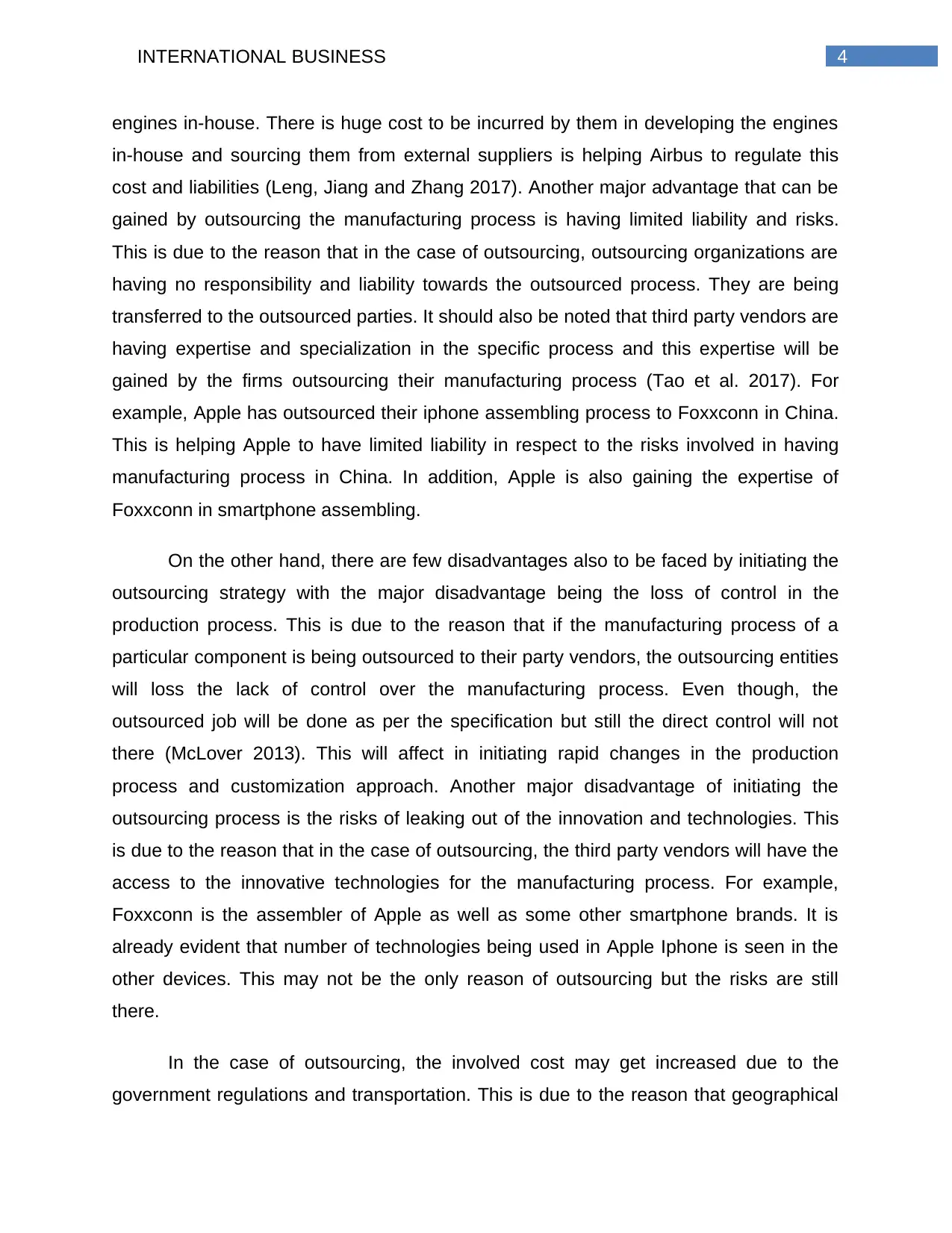
4INTERNATIONAL BUSINESS
engines in-house. There is huge cost to be incurred by them in developing the engines
in-house and sourcing them from external suppliers is helping Airbus to regulate this
cost and liabilities (Leng, Jiang and Zhang 2017). Another major advantage that can be
gained by outsourcing the manufacturing process is having limited liability and risks.
This is due to the reason that in the case of outsourcing, outsourcing organizations are
having no responsibility and liability towards the outsourced process. They are being
transferred to the outsourced parties. It should also be noted that third party vendors are
having expertise and specialization in the specific process and this expertise will be
gained by the firms outsourcing their manufacturing process (Tao et al. 2017). For
example, Apple has outsourced their iphone assembling process to Foxxconn in China.
This is helping Apple to have limited liability in respect to the risks involved in having
manufacturing process in China. In addition, Apple is also gaining the expertise of
Foxxconn in smartphone assembling.
On the other hand, there are few disadvantages also to be faced by initiating the
outsourcing strategy with the major disadvantage being the loss of control in the
production process. This is due to the reason that if the manufacturing process of a
particular component is being outsourced to their party vendors, the outsourcing entities
will loss the lack of control over the manufacturing process. Even though, the
outsourced job will be done as per the specification but still the direct control will not
there (McLover 2013). This will affect in initiating rapid changes in the production
process and customization approach. Another major disadvantage of initiating the
outsourcing process is the risks of leaking out of the innovation and technologies. This
is due to the reason that in the case of outsourcing, the third party vendors will have the
access to the innovative technologies for the manufacturing process. For example,
Foxxconn is the assembler of Apple as well as some other smartphone brands. It is
already evident that number of technologies being used in Apple Iphone is seen in the
other devices. This may not be the only reason of outsourcing but the risks are still
there.
In the case of outsourcing, the involved cost may get increased due to the
government regulations and transportation. This is due to the reason that geographical
engines in-house. There is huge cost to be incurred by them in developing the engines
in-house and sourcing them from external suppliers is helping Airbus to regulate this
cost and liabilities (Leng, Jiang and Zhang 2017). Another major advantage that can be
gained by outsourcing the manufacturing process is having limited liability and risks.
This is due to the reason that in the case of outsourcing, outsourcing organizations are
having no responsibility and liability towards the outsourced process. They are being
transferred to the outsourced parties. It should also be noted that third party vendors are
having expertise and specialization in the specific process and this expertise will be
gained by the firms outsourcing their manufacturing process (Tao et al. 2017). For
example, Apple has outsourced their iphone assembling process to Foxxconn in China.
This is helping Apple to have limited liability in respect to the risks involved in having
manufacturing process in China. In addition, Apple is also gaining the expertise of
Foxxconn in smartphone assembling.
On the other hand, there are few disadvantages also to be faced by initiating the
outsourcing strategy with the major disadvantage being the loss of control in the
production process. This is due to the reason that if the manufacturing process of a
particular component is being outsourced to their party vendors, the outsourcing entities
will loss the lack of control over the manufacturing process. Even though, the
outsourced job will be done as per the specification but still the direct control will not
there (McLover 2013). This will affect in initiating rapid changes in the production
process and customization approach. Another major disadvantage of initiating the
outsourcing process is the risks of leaking out of the innovation and technologies. This
is due to the reason that in the case of outsourcing, the third party vendors will have the
access to the innovative technologies for the manufacturing process. For example,
Foxxconn is the assembler of Apple as well as some other smartphone brands. It is
already evident that number of technologies being used in Apple Iphone is seen in the
other devices. This may not be the only reason of outsourcing but the risks are still
there.
In the case of outsourcing, the involved cost may get increased due to the
government regulations and transportation. This is due to the reason that geographical
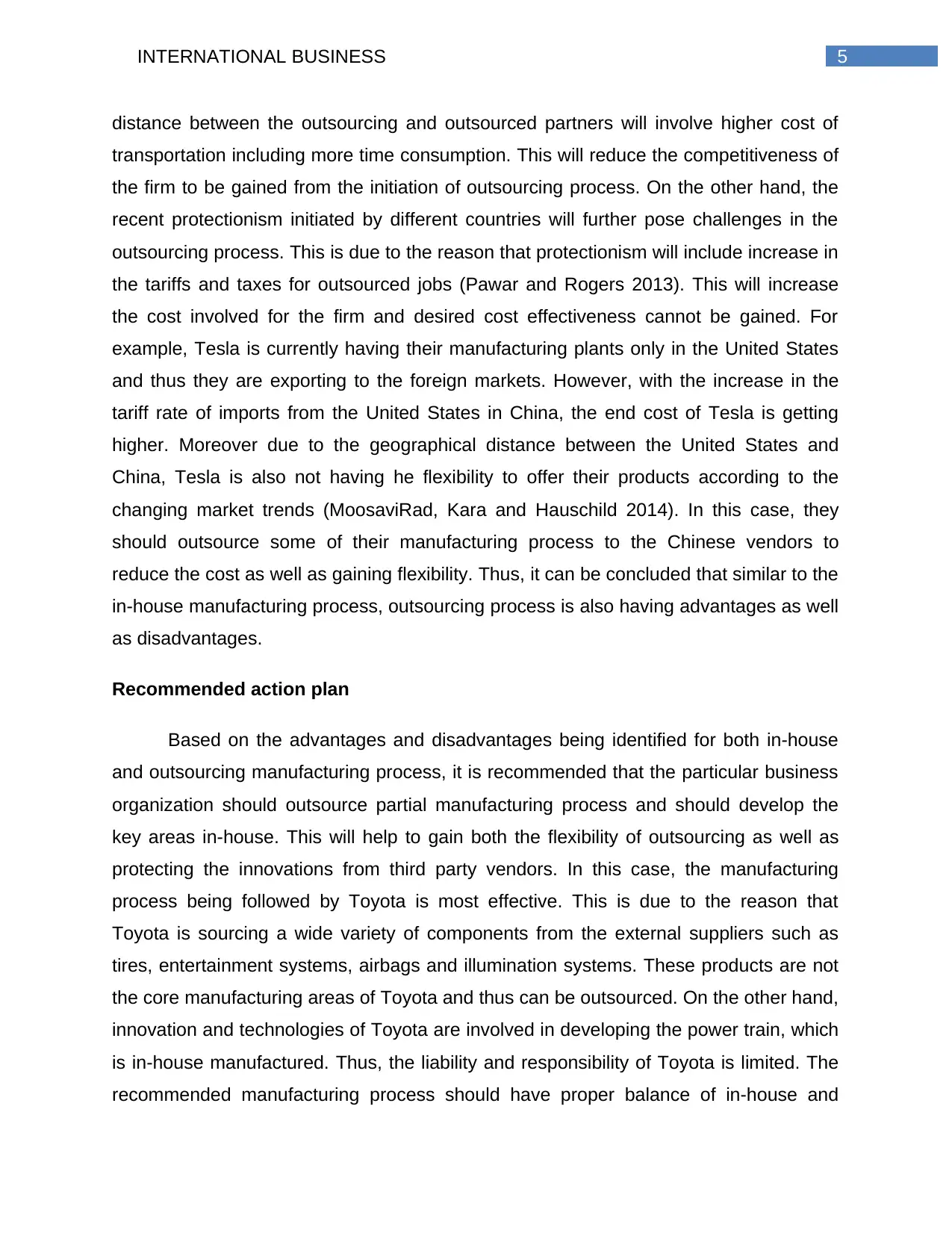
5INTERNATIONAL BUSINESS
distance between the outsourcing and outsourced partners will involve higher cost of
transportation including more time consumption. This will reduce the competitiveness of
the firm to be gained from the initiation of outsourcing process. On the other hand, the
recent protectionism initiated by different countries will further pose challenges in the
outsourcing process. This is due to the reason that protectionism will include increase in
the tariffs and taxes for outsourced jobs (Pawar and Rogers 2013). This will increase
the cost involved for the firm and desired cost effectiveness cannot be gained. For
example, Tesla is currently having their manufacturing plants only in the United States
and thus they are exporting to the foreign markets. However, with the increase in the
tariff rate of imports from the United States in China, the end cost of Tesla is getting
higher. Moreover due to the geographical distance between the United States and
China, Tesla is also not having he flexibility to offer their products according to the
changing market trends (MoosaviRad, Kara and Hauschild 2014). In this case, they
should outsource some of their manufacturing process to the Chinese vendors to
reduce the cost as well as gaining flexibility. Thus, it can be concluded that similar to the
in-house manufacturing process, outsourcing process is also having advantages as well
as disadvantages.
Recommended action plan
Based on the advantages and disadvantages being identified for both in-house
and outsourcing manufacturing process, it is recommended that the particular business
organization should outsource partial manufacturing process and should develop the
key areas in-house. This will help to gain both the flexibility of outsourcing as well as
protecting the innovations from third party vendors. In this case, the manufacturing
process being followed by Toyota is most effective. This is due to the reason that
Toyota is sourcing a wide variety of components from the external suppliers such as
tires, entertainment systems, airbags and illumination systems. These products are not
the core manufacturing areas of Toyota and thus can be outsourced. On the other hand,
innovation and technologies of Toyota are involved in developing the power train, which
is in-house manufactured. Thus, the liability and responsibility of Toyota is limited. The
recommended manufacturing process should have proper balance of in-house and
distance between the outsourcing and outsourced partners will involve higher cost of
transportation including more time consumption. This will reduce the competitiveness of
the firm to be gained from the initiation of outsourcing process. On the other hand, the
recent protectionism initiated by different countries will further pose challenges in the
outsourcing process. This is due to the reason that protectionism will include increase in
the tariffs and taxes for outsourced jobs (Pawar and Rogers 2013). This will increase
the cost involved for the firm and desired cost effectiveness cannot be gained. For
example, Tesla is currently having their manufacturing plants only in the United States
and thus they are exporting to the foreign markets. However, with the increase in the
tariff rate of imports from the United States in China, the end cost of Tesla is getting
higher. Moreover due to the geographical distance between the United States and
China, Tesla is also not having he flexibility to offer their products according to the
changing market trends (MoosaviRad, Kara and Hauschild 2014). In this case, they
should outsource some of their manufacturing process to the Chinese vendors to
reduce the cost as well as gaining flexibility. Thus, it can be concluded that similar to the
in-house manufacturing process, outsourcing process is also having advantages as well
as disadvantages.
Recommended action plan
Based on the advantages and disadvantages being identified for both in-house
and outsourcing manufacturing process, it is recommended that the particular business
organization should outsource partial manufacturing process and should develop the
key areas in-house. This will help to gain both the flexibility of outsourcing as well as
protecting the innovations from third party vendors. In this case, the manufacturing
process being followed by Toyota is most effective. This is due to the reason that
Toyota is sourcing a wide variety of components from the external suppliers such as
tires, entertainment systems, airbags and illumination systems. These products are not
the core manufacturing areas of Toyota and thus can be outsourced. On the other hand,
innovation and technologies of Toyota are involved in developing the power train, which
is in-house manufactured. Thus, the liability and responsibility of Toyota is limited. The
recommended manufacturing process should have proper balance of in-house and
⊘ This is a preview!⊘
Do you want full access?
Subscribe today to unlock all pages.

Trusted by 1+ million students worldwide
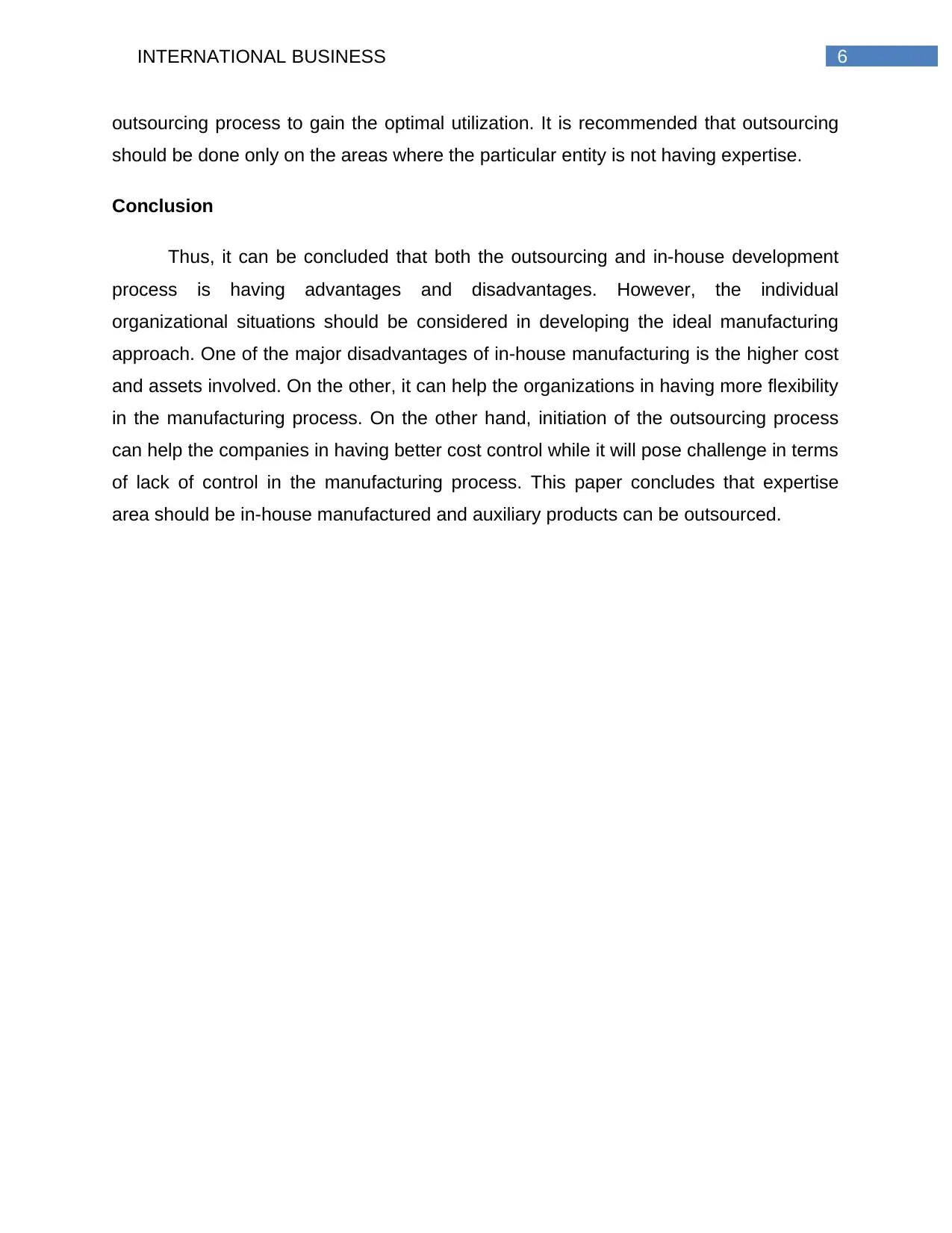
6INTERNATIONAL BUSINESS
outsourcing process to gain the optimal utilization. It is recommended that outsourcing
should be done only on the areas where the particular entity is not having expertise.
Conclusion
Thus, it can be concluded that both the outsourcing and in-house development
process is having advantages and disadvantages. However, the individual
organizational situations should be considered in developing the ideal manufacturing
approach. One of the major disadvantages of in-house manufacturing is the higher cost
and assets involved. On the other, it can help the organizations in having more flexibility
in the manufacturing process. On the other hand, initiation of the outsourcing process
can help the companies in having better cost control while it will pose challenge in terms
of lack of control in the manufacturing process. This paper concludes that expertise
area should be in-house manufactured and auxiliary products can be outsourced.
outsourcing process to gain the optimal utilization. It is recommended that outsourcing
should be done only on the areas where the particular entity is not having expertise.
Conclusion
Thus, it can be concluded that both the outsourcing and in-house development
process is having advantages and disadvantages. However, the individual
organizational situations should be considered in developing the ideal manufacturing
approach. One of the major disadvantages of in-house manufacturing is the higher cost
and assets involved. On the other, it can help the organizations in having more flexibility
in the manufacturing process. On the other hand, initiation of the outsourcing process
can help the companies in having better cost control while it will pose challenge in terms
of lack of control in the manufacturing process. This paper concludes that expertise
area should be in-house manufactured and auxiliary products can be outsourced.
Paraphrase This Document
Need a fresh take? Get an instant paraphrase of this document with our AI Paraphraser
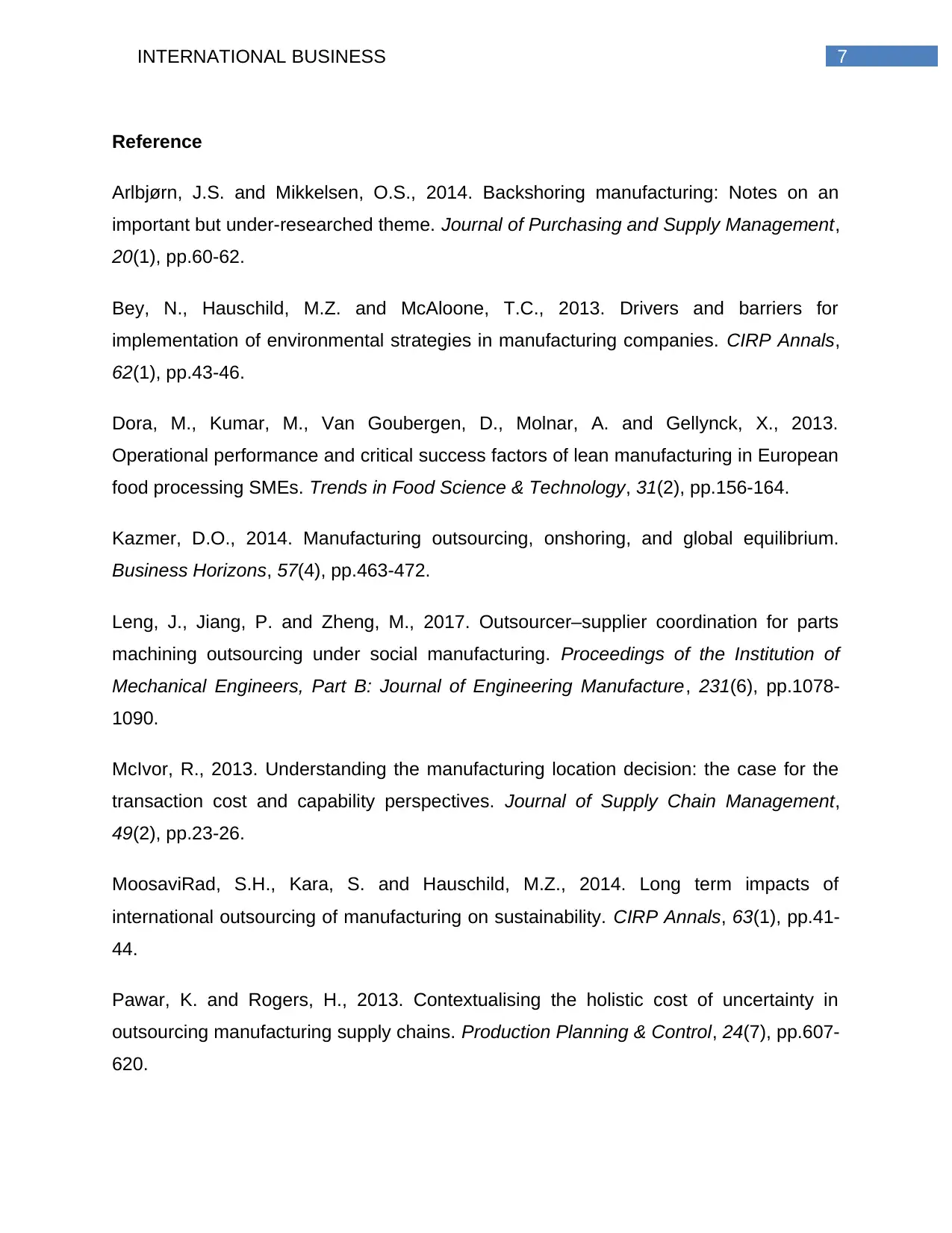
7INTERNATIONAL BUSINESS
Reference
Arlbjørn, J.S. and Mikkelsen, O.S., 2014. Backshoring manufacturing: Notes on an
important but under-researched theme. Journal of Purchasing and Supply Management,
20(1), pp.60-62.
Bey, N., Hauschild, M.Z. and McAloone, T.C., 2013. Drivers and barriers for
implementation of environmental strategies in manufacturing companies. CIRP Annals,
62(1), pp.43-46.
Dora, M., Kumar, M., Van Goubergen, D., Molnar, A. and Gellynck, X., 2013.
Operational performance and critical success factors of lean manufacturing in European
food processing SMEs. Trends in Food Science & Technology, 31(2), pp.156-164.
Kazmer, D.O., 2014. Manufacturing outsourcing, onshoring, and global equilibrium.
Business Horizons, 57(4), pp.463-472.
Leng, J., Jiang, P. and Zheng, M., 2017. Outsourcer–supplier coordination for parts
machining outsourcing under social manufacturing. Proceedings of the Institution of
Mechanical Engineers, Part B: Journal of Engineering Manufacture, 231(6), pp.1078-
1090.
McIvor, R., 2013. Understanding the manufacturing location decision: the case for the
transaction cost and capability perspectives. Journal of Supply Chain Management,
49(2), pp.23-26.
MoosaviRad, S.H., Kara, S. and Hauschild, M.Z., 2014. Long term impacts of
international outsourcing of manufacturing on sustainability. CIRP Annals, 63(1), pp.41-
44.
Pawar, K. and Rogers, H., 2013. Contextualising the holistic cost of uncertainty in
outsourcing manufacturing supply chains. Production Planning & Control, 24(7), pp.607-
620.
Reference
Arlbjørn, J.S. and Mikkelsen, O.S., 2014. Backshoring manufacturing: Notes on an
important but under-researched theme. Journal of Purchasing and Supply Management,
20(1), pp.60-62.
Bey, N., Hauschild, M.Z. and McAloone, T.C., 2013. Drivers and barriers for
implementation of environmental strategies in manufacturing companies. CIRP Annals,
62(1), pp.43-46.
Dora, M., Kumar, M., Van Goubergen, D., Molnar, A. and Gellynck, X., 2013.
Operational performance and critical success factors of lean manufacturing in European
food processing SMEs. Trends in Food Science & Technology, 31(2), pp.156-164.
Kazmer, D.O., 2014. Manufacturing outsourcing, onshoring, and global equilibrium.
Business Horizons, 57(4), pp.463-472.
Leng, J., Jiang, P. and Zheng, M., 2017. Outsourcer–supplier coordination for parts
machining outsourcing under social manufacturing. Proceedings of the Institution of
Mechanical Engineers, Part B: Journal of Engineering Manufacture, 231(6), pp.1078-
1090.
McIvor, R., 2013. Understanding the manufacturing location decision: the case for the
transaction cost and capability perspectives. Journal of Supply Chain Management,
49(2), pp.23-26.
MoosaviRad, S.H., Kara, S. and Hauschild, M.Z., 2014. Long term impacts of
international outsourcing of manufacturing on sustainability. CIRP Annals, 63(1), pp.41-
44.
Pawar, K. and Rogers, H., 2013. Contextualising the holistic cost of uncertainty in
outsourcing manufacturing supply chains. Production Planning & Control, 24(7), pp.607-
620.
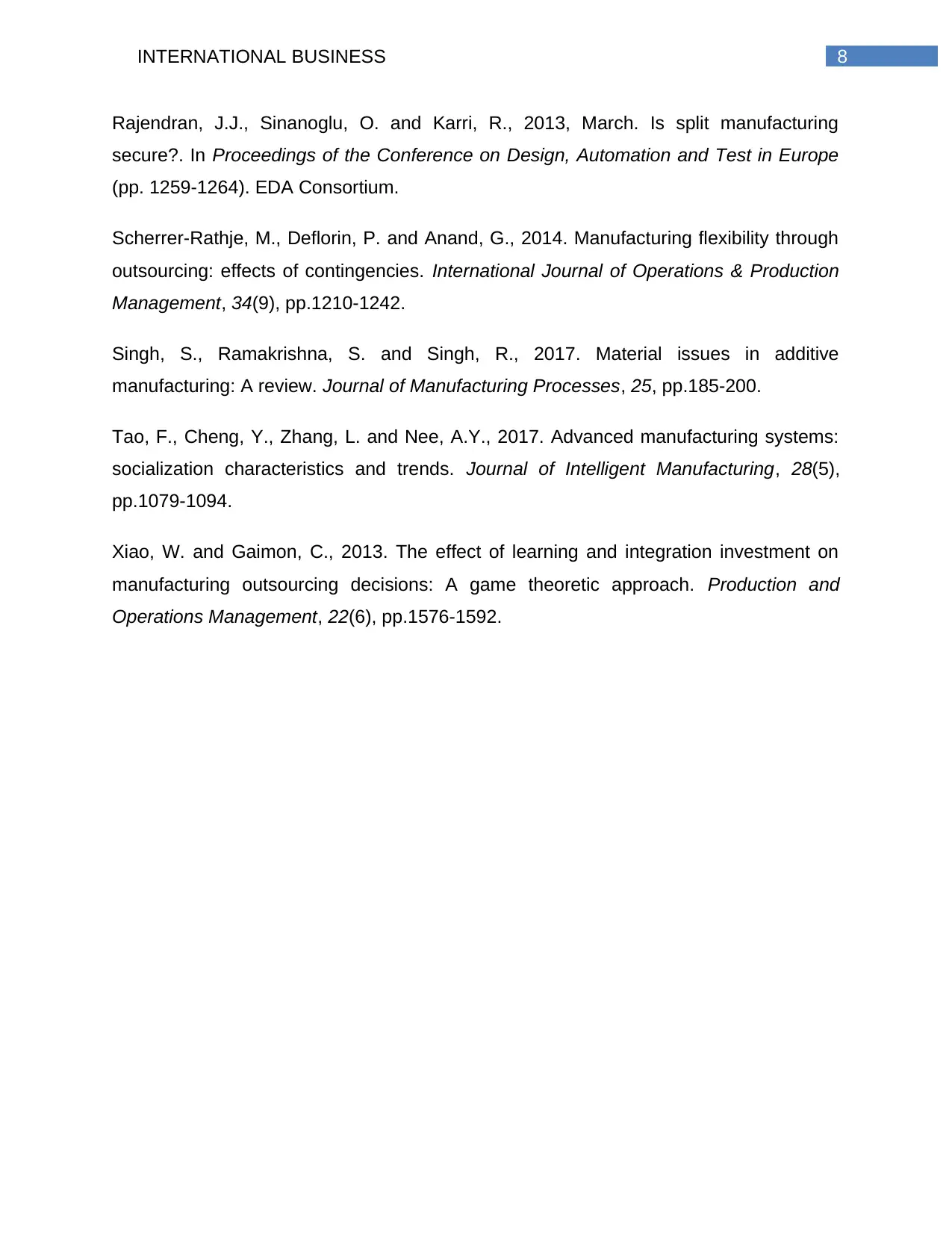
8INTERNATIONAL BUSINESS
Rajendran, J.J., Sinanoglu, O. and Karri, R., 2013, March. Is split manufacturing
secure?. In Proceedings of the Conference on Design, Automation and Test in Europe
(pp. 1259-1264). EDA Consortium.
Scherrer-Rathje, M., Deflorin, P. and Anand, G., 2014. Manufacturing flexibility through
outsourcing: effects of contingencies. International Journal of Operations & Production
Management, 34(9), pp.1210-1242.
Singh, S., Ramakrishna, S. and Singh, R., 2017. Material issues in additive
manufacturing: A review. Journal of Manufacturing Processes, 25, pp.185-200.
Tao, F., Cheng, Y., Zhang, L. and Nee, A.Y., 2017. Advanced manufacturing systems:
socialization characteristics and trends. Journal of Intelligent Manufacturing, 28(5),
pp.1079-1094.
Xiao, W. and Gaimon, C., 2013. The effect of learning and integration investment on
manufacturing outsourcing decisions: A game theoretic approach. Production and
Operations Management, 22(6), pp.1576-1592.
Rajendran, J.J., Sinanoglu, O. and Karri, R., 2013, March. Is split manufacturing
secure?. In Proceedings of the Conference on Design, Automation and Test in Europe
(pp. 1259-1264). EDA Consortium.
Scherrer-Rathje, M., Deflorin, P. and Anand, G., 2014. Manufacturing flexibility through
outsourcing: effects of contingencies. International Journal of Operations & Production
Management, 34(9), pp.1210-1242.
Singh, S., Ramakrishna, S. and Singh, R., 2017. Material issues in additive
manufacturing: A review. Journal of Manufacturing Processes, 25, pp.185-200.
Tao, F., Cheng, Y., Zhang, L. and Nee, A.Y., 2017. Advanced manufacturing systems:
socialization characteristics and trends. Journal of Intelligent Manufacturing, 28(5),
pp.1079-1094.
Xiao, W. and Gaimon, C., 2013. The effect of learning and integration investment on
manufacturing outsourcing decisions: A game theoretic approach. Production and
Operations Management, 22(6), pp.1576-1592.
⊘ This is a preview!⊘
Do you want full access?
Subscribe today to unlock all pages.

Trusted by 1+ million students worldwide
1 out of 9
Related Documents
Your All-in-One AI-Powered Toolkit for Academic Success.
+13062052269
info@desklib.com
Available 24*7 on WhatsApp / Email
![[object Object]](/_next/static/media/star-bottom.7253800d.svg)
Unlock your academic potential
Copyright © 2020–2025 A2Z Services. All Rights Reserved. Developed and managed by ZUCOL.




